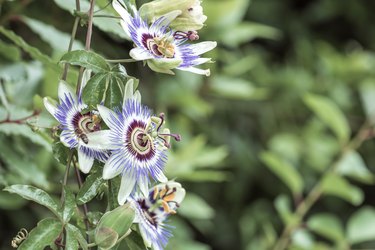
Things You'll Need
Container
Potting mix
Water
Fertilizer
Fence, arbor, wall or trellis
Pruning shears
Passion flower, Passiflora, encompasses more than 500 species. Depending on the cultivar, such as Passiflora incarnata, some are hardy as far north as U.S. Department of Agriculture plant hardiness zone 6. Others, such as Passiflora racemosa, prefer a warmer, frost-free, subtropical climate. A vigorous vine, gardeners living throughout the United States can grow passion flower in containers for winter protection. Vines can grow up to 30 feet long, requiring a trellis, wall or other support. Flowers range in colors from purples to reds and grow up to 3 inches across. Some varieties produce edible fruits.
Step 1: Choose the Container to Plant Passion Flower in a Pot
Grow passion flower vine in a container that is approximately two to three times larger than the plant's root ball. Select a container with drain holes -- the vine will die if planted into a nondraining container that holds water. Note that soil in a wooden or clay container dries out more quickly than soil in a container made of plastic.
Video of the Day
Step 2: Prepare the Container
Fill the container half full with a rich, well-drained potting mix. Passion flower prefers to grow in soil that drains very well and is full of organic materials.
Step 3: Plant the Passion Vine in the Container
Remove the passion flower from its original container. Place the plant inside the new container. Fill the container with soil and press down lightly, firming it around the plant's base.
Step 4: Water the Passion Plant Thoroughly
Water the container after planting, allowing water to run out the bottom holes. Keep the soil moist with regular watering, which produces the best growth and helps the plant flower almost year-round.
Step 5: Feed the Passion Plant
Fertilize the passion fruit vine in four applications, evenly spaced throughout the year. Apply a 10-5-20 fertilizer blend according to the package directions. Fertilizing with a blend that is high in nitrogen promotes foliage growth, but flowering may be less.
Step 6: Provide Adequate Sunlight
Situate the container in an area receiving full sun, if your climate is not prone to intense, hot weather. Place the passion flower vine's container in an area receiving partial sun throughout the day for the best growth in hot climates.
Step 7: Give the Plant Support
Provide support for the vine as it grows. Position the container six inches to 1 foot away from a wooden or chain-link fence, arbor, wall or trellis.
Step 8: Prune the Passion Flower Vine
Prune your passion flower vine to control its size and remove deadwood. Passion flower vines have a vigorous growth habit, growing 15 to 20 feet yearly. Trim the plant springtime if you live in a cooler area that experiences frosts; prune after harvesting any fruits if you live in a warmer region.
Step 9: Protect the Passion Plant From Frost
Protect plants in frost-prone areas by bringing the container inside to a warm, sunny location. Cut the passion flower down to 1 to 2 feet tall, so its indoor growth is more controllable until you place it back outdoors in springtime.
Tip
Passion flower vines are the sole larval food for more than 70 species of butterflies. Fruiting varieties of passion flower produce their first crop of fruits one to three years after planting. Passion flower fruits typically are ready for harvesting in 70 to 80 days, depending on the cultivar.
Video of the Day